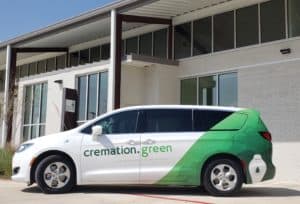Although cremation is the most common form of disposition today, over 35% of people still elect to be buried. Most of those burials are “traditional” burials that involve full funeral services, embalming fluid, ornate caskets and pouring a cement liner once the casket has been lowered into the grave. All of that expensive excess is a major factor for why fewer people are being buried.
Natural burial is a very different process. It’s much simpler, the way burial was before the Civil War when embalming fluid and commercial funeral services weren’t the norm. With natural burial the body is preserved using natural methods until the deceased can be buried in a biodegradable vessel such as a pine coffin, wicker basket or cotton burial shroud. Typically, the burial occurs within a few days of the death.
Given that natural burial is safer and greener than traditional burial you’d think it would be allowed in even more places. However, because green burial has to meet certain requirements and follow certain standards to be considered “natural”, the practice is sometimes limited to certain areas. Below are three possible places where natural burial can occur in Texas.
Traditional Cemeteries
The deceased are usually buried in a traditional cemetery because they are well established all over the country. However, a growing number of traditional cemeteries are dedicating a portion of their grounds for natural burials. The cemetery managers understand that public sentiment is changing and more people are beginning to prefer natural burial so they must be able to accommodate it along with traditional burials.
Each cemetery will have its own guidelines for natural burial. Check to see what needs to be done and what restrictions apply to natural burial at your cemetery of choice. Be prepared that the burial plots may be more expensive than traditional burial plots if the space is limited or there are no other cemeteries offering natural burial.
Natural Burial Parks
There are now what’s known as natural burial parks. These are burial grounds that are solely for natural burial. They are conceived from the start to prioritize land preservation and minimize the ecological impact of disposition services.
Many natural burial parks don’t resemble a traditional cemetery. They tend to be in rural settings with few to no man-made structures. There may not even be headstones at the gravesites. Instead graves may only be marked by a rock, plant or other natural landmark.
Families that choose green burial tend to gravitate to natural burial parks because they offer a tranquil final resting place that isn’t detracting from nature. Eloise Woods Natural Burial Park is one such burial ground in Bastrop County, TX. The park follows conservation burial practices as outlined by the Green Burial Council. Eloise Woods Natural Burial Park takes the approach that their burial grounds are an emotional landscape. It’s where emotions and experiences happen in nature creating an important connection.
This is an important point because it highlights the different approach a natural burial park may take compared to a traditional cemetery. Often, they feel more like a quiet park than a final resting place.
Private Property
Texas is a state that isn’t very restrictive about burial. Some states don’t allow burials on private properties at all while others require special permitting that can take time and effort to obtain. In Texas, the owner of the property needs to allow the burial and the burial needs to be documented. There are very few other limitations regarding burial on private property in Texas other than how close the property is to the closest city boundary.
However, there could be local laws and regulations that limit where burials can happen. For example, zoning laws could come into play. The city or county clerk will be able to provide answers regarding local regulations that affect burials at a private property.
The state regulations for burying the deceased on private property, often referred to as a home burial, are outlined in the Texas Health and Safety Code. You can even have a private family cemetery in Texas if more than one person is buried at the site. However, there are restrictions in regards to where a family cemetery is located so check with local officials first. Generally, the cemetery needs to be 1-5 miles away from the city boundaries. The distance will depend on the size of the city’s population. You may also need to have a survey showing the location of the family cemetery before being given approval.
What to Remember Wherever Natural Burial Occurs
No matter where the burial occurs, the grave should be at least 1.5 feet deep if a traditional impenetrable casket is used and 2 feet if a biodegradable receptacle is used. This is the standard minimum to ensure that the grave isn’t disturbed by wildlife. Many people prefer to dig the grave 3 feet deep to err on the side of caution. That’s a good idea because graves that are below the minimum can lead to a misdemeanor charge even if it is accidental.
Natural Burial for Cremated Remains
Natural burial is an option for burying cremated remains as well. Biodegradable receptacles can be used and the cremains can be treated to ensure they don’t negatively impact the soil. You may even be able to grow a plant if the proper preparations are made. Of course, if you are planning a burial at a natural burial park only native plants should be used.
Cremation.Green can help you arrange a natural burial in Texas. We have close contacts with natural burial parks and cemeteries across the state, and our team fully understands the laws regarding natural burial in the state. Contact us any time by phone, text or email to discuss natural burial arrangements.






